Review: Cherry Audio Sines – wobbly waves and folded timbres
Sines is a polyphonic software synthesizer that combines stacks of sine waves with folded tones, additive and FM synthesis and puts everything on the page.
Sines
It’s difficult to call something unique when you’re simply combining different forms of synthesis in a synthesizer. We’ve become familiar with West Coast meets East Coast, hybrid synthesis and the borrowing of ideas from a range of traditions. But in this mix of ideas, Cherry Audio is putting forward a different way of doing things that it hopes will inspire and capture something interesting.
As a Sinusoidal Synthesizer, this is all about starting with sine waves. You have four sine-wave oscillators, and the idea is that through the undulating part of the interface, you can shape, bend and fold those waveforms into a vast range of timbres. The tools on offer include Feedback, Phase, Width, Shape, Wavefold and Drive. As you move each one, a mini oscilloscope shows you exactly what’s going on with the waveform. You can slide in a sub-oscillator and a “super”-oscillator which is an octave up for added ballast. With the Phase Modulation and Ratio controls, you can configure it into a 4-operator FM-style synth.
You are currently viewing a placeholder content from YouTube. To access the actual content, click the button below. Please note that doing so will share data with third-party providers.
Voices
For voicing and modulation, Sines has four of everything; four oscillators, four LFOs, and four Envelopes. You can run a single row completely independently or start layering them up or feeding them into each other. Everything can pretty much modulate everything else – that seems to be the vibe. The extensiveness of the control tends to put a lot of knobs on the screen, but then Cherry Audio wants you to have access to everything.
After the shaping comes a multimode filter and a selection of effects, including Delay, Reverb, Modulation and Distortion. There’s an arpeggiator and an 8-band parametric EQ right on the front panel. At the end, there’s a Drift function just to give it that vintage flavour of never quite being in tune with itself.
So, that’s the basic idea. How well does it work in practice?
First Impressions
I’ve said a few times that Cherry Audio’s synths lack a certain something in regard to their interfaces, and Sines embraces a similar level of half-decent mediocrity. However, those curves are very disarming. It upsets the desire for order and uniformity in a really pleasing and intriguing way. It softens the otherwise rather overwhelming array of knobs that we see before us.
The layout is relatively straightforward, with a stack of four LFOs followed by four oscillators flowing towards four envelopes. There’s a filter, almost as an afterthought, stuck in the top right, with a suspiciously small Mod Matrix underneath. Then above the keyboard is a row of effects and processing. The focus is wholeheartedly on the shaping of those sine waves. That’s what all this is about, and I think it’s going to get fascinating really quickly.
The first preset I selected was called Ambient Nation, and that, for me, nails the basic functionality of this synth. It’s a complete dream, and I spent my first hour just soaking it up and experiencing the shaping tools.
Let me describe what I mean.
Ambient Nation is a chord preset, so you only need to play a single note. The sound washes in with mellow sine waves that are slowly beating against one another in a deliciously radiant fashion. It’s part organ, part sunrise, part pulsing heart and just lovely. Hit the Focus button to zoom in on the shaping section of the first oscillator, and also so you can see the oscilloscope. Then, just spend some time on each knob in turn. You’ll hear the changes flitting through the patch, rounded out with reverb and delay, you’ll see the waveform change and modulate. This is sublime.
Each of the shaping controls has a personal modulation source selection button. You can bring in anything you like to modulate it, from LFOs, envelopes, other oscillators, noise, keyboard elements and so on. The movement you can get going on is quite extraordinary, and a green/red halo around the knob shows you what’s in play.
I think I get it. I think I can see the unique experience that Cherry Audio are after. And this is just my first preset.
Sines Presets
There are 500 presets in here, no doubt designed by very deep and clever people, as these things usually are. They cover all the familiar synthesizer instrument categories like Basses, Brass, Leads and Strings, but you’ve also got more FM-style sounds like Bells and Plucks. I thought, because of the nature of the synth, they’d be more organs, but there are certainly some to get your teeth into. I say that because of the organ-style octave switches and the way additive lends itself to pipes.
There are a lot of basses in here and probably too many regular synth-style tones. It’s one of those things where while the sine wave stacking and shaping brings a unique flavour to Sines, it’s all too easy to shape them into sawtooth and square waves and pretend like it’s any other synth. That said, there are a bunch of really great FM basses in here that sound just like my old DX100. The Bells are also on the money.
Arping and padding
I enjoy a good arpeggiator, and there’s a very pleasing section where melodies rule the day. There are lots of beautiful patches in here, along with some of the fiercest bass lines I’ve ever heard. For example, Happy Astro Surver is a delight in dancing waveforms, flashing modulations and a fabulous reveal as you release the filter. Whereas Nasal Lines pulses out a mean 303-type bass while Courderoy Pants is a barely contained filter festival.
The biggest section is Pads, and rightly so, as if nothing else, Sines lends itself to evolving and emotive textures. It’s just a lovely place to spend some time. Some of my favourites include Luna Rise and A Star Gazers View with their playful bouncing ball rhythms, the fizzing of Oh No Computer and the pure gravity of One Note Meditator.
A lot of ground is being covered here, and Cherry Audio suggests that if the front end feels a bit complex, then playing in the presets is a good place to get a sense of the synth. It’s not wrong. But on the one hand, you get a really quite fabulous array of juicy synth sounds, whereas on the other, you might miss the playfulness of the basic sine-based synthesis.
Initialise Sines patch
So let’s have a look at the basics and see how inspirational and unique they can be.
Hit “New” and start a freshly initialised patch, and you’re faced with a very dull sine wave. It’s at this point that you have to struggle with the interface a bit until you can identify the parts you need and remember where they are. Initially, you only have the output of a single oscillator, but how do you turn on the others? You spend a few moments looking at the LFOs and their flashing LEDs because you tend to read synths from left to right, before realising they are LFOs and have nothing to do with the sine wave oscillators. Right, so the oscillators come next but is there a button to turn them on or can I find any indication as to why they’re not making any sound? You follow the oscillators through their wave of shaping tools until you find the rather non-descript Level and Pan controls right at the end.
Ok, now you can stack up some more sine waves, and it immediately gets interesting. The interest comes from the sneaky Drift control being set to 10% by default. This injects a little bit of detuning between the oscillators, so you get that slow modulation between the waveforms. It’s really nice. And then, just like I did with the first preset I played with, I started messing with the shaping tools.
Just using a couple of oscillators and turning knobs, you find yourself building up a fascinating organ-synth hybrid of a sound. Everything does something. The waveforms flex and morph, you can switch up octaves or bring in the sub or super oscillator for instant boosts and transformations. It feels like a polyphonic modular patch, and this is before switching in any modulation or adding effects.
Modulation
I like what Cherry Audio has done with the modulation. I find that modulation matrixes can often get a bit unwieldy. I’m left wondering how this grid of connections actually relates to the parameters I see on the synth. With Sines, you get a quite restrained four-slot matrix. In there you can construct a modulation system routing to up to four parameters. But the more important modulation goes on with each individual shaping knob.
Above each of the seven knobs for each oscillator is a little modulation button where you can select a Source, and, in the case of the Freq and Phase knobs, a Via modulator as well. Lights around the knob nicely animate to show you what’s going on. This is really where the power of Sines lies. You are encouraged to modulate every parameter. You’re not getting lost in a matrix somewhere, you have the ability to modulate and control it right there next to the knob, and so you never lose track of what’s going on.
LFOs
The LFOs are very competent with a good range of waveforms, uni and bipolar options, with sync, one shot and triggering. You can have them free-flowing or locked into your tempo and I always enjoy a good one-shot modulator. The one thing missing is perhaps some delay to the start of the modulation. However, there is a delay option on the envelopes, so you could feasibly use an envelope to delay the start of an LFO. But it feels like an oversight.
Envelopes
For the Envelopes, Cherry Audio has decided to call the first two Filter Env and Amp Env although it’s only the Amp Env that’s hard-wired, everything else is freely assignable. They are regular ADSR jobbies with a velocity element and the aforementioned Delay knob.
For FM purposes, you will need to use oscillators as modulators, and that’s all there under the Source button. It’s no bother and lets you experiment with audio-rate modulation, ratios and frequencies without having any clue what you’re doing.
Effects
We all know that effects can make any old synth sound fantastic, but we’d also be sad if they weren’t included. Cherry Audio says it included a range of its best effects, and these certainly sound great. The Reverb is lush, the Delay is echoey with a nice Spread element, the Chorus is suitably chewy, and the Distortion is nasty and fabulous.
The 8-band EQ is a little more unusual. It’s like having a filter bank giving you the opportunity to shape the frequency content a bit more deliberately. It can completely change the intention of the patch you’re making, which is very interesting indeed.
And it’s also worth pointing out that the effects appear as destinations in the modulation matrix. This means you can modulate their parameters. That’s not always something that happens in synths, and is good to see.
Conclusion
Who knew that playing with sine waves could be so much fun? Sines really leans into the sound designer in me. It’s where I want to do more with a synth than simply play with the filter. The shaping of the sine waves feels very modular and very deliberate. It’s like you can lose yourself in a single oscillator that morphs and folds, phases and splits. The interplay between the oscillators can get deliciously juicy, and you can just keep on pulling the levers for huge sounds, endless changes, movements and possibilities. And that’s just dipping your toes in and playing on the surface.
There are a lot of deeper levels available to you in the realms of FM and audio rate modulations which could be interesting or baffling, depending on your point of view. But what I like is that everything is out on the front; there are no hidden operator algorithms or cleverness; you’re just routing oscillators into each other and turning the knobs.
The interface works well enough for you to navigate to what you need to do. I’d like a bit more differentiation between the sections as the colour doesn’t separate things very well. Also, I’d like to be able to turn oscillators on and off rather than just having a level control. Maybe the ability to add further modulations to a single control would be good. Most knobs can only take a single source, although you can combine two sources (SRC and VIA) in the Mod Matrix – it might be good to add the “Via” option to every knob.
Is Sines Unique?
I can’t say if Sines is unique, but the workflow is certainly uncommon in a polyphonic synthesizer. It’s a really interesting piece of work that’s given me a way of mixing waveforms that I don’t often consider. There are some big sounds in here. For Pad and ambient junkies like myself, it has an immense amount of movement, morphing and modulating possibilities and textures that you haven’t begun to discover.
Cherry Audio Sines is available for macOS and Windows for the ridiculous price of $49. You can also download a demo to try it out for yourself.

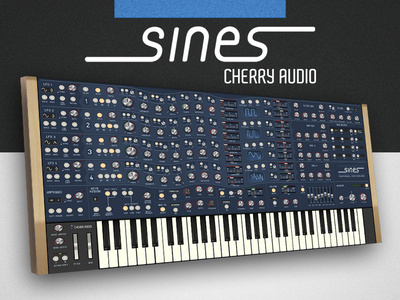
2 responses to “Review: Cherry Audio Sines – wobbly waves and folded timbres”

 4,3 / 5,0 |
4,3 / 5,0 | 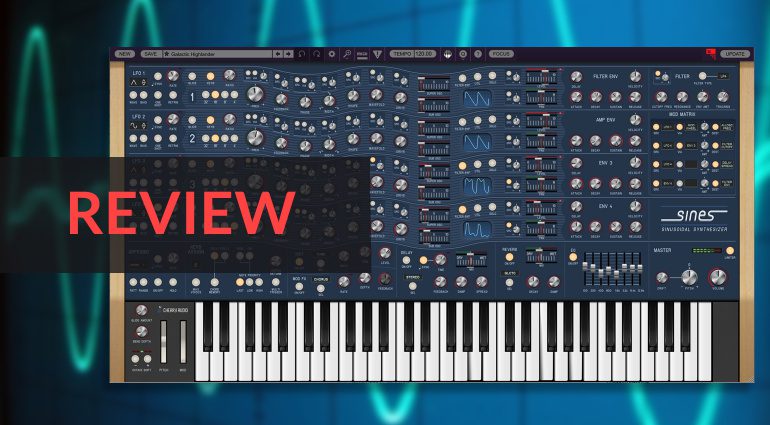
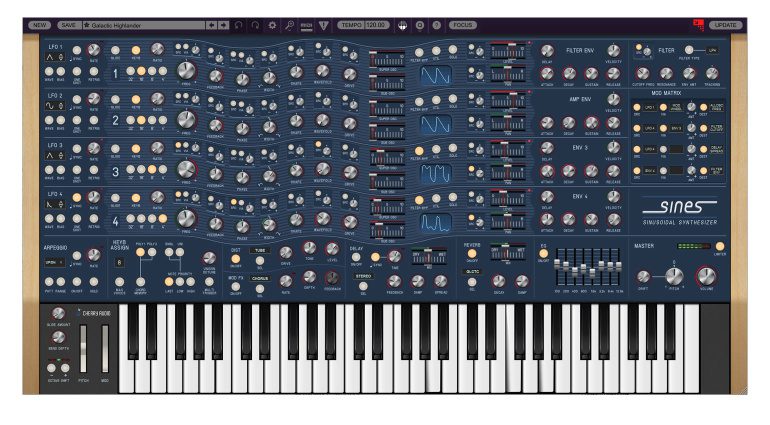
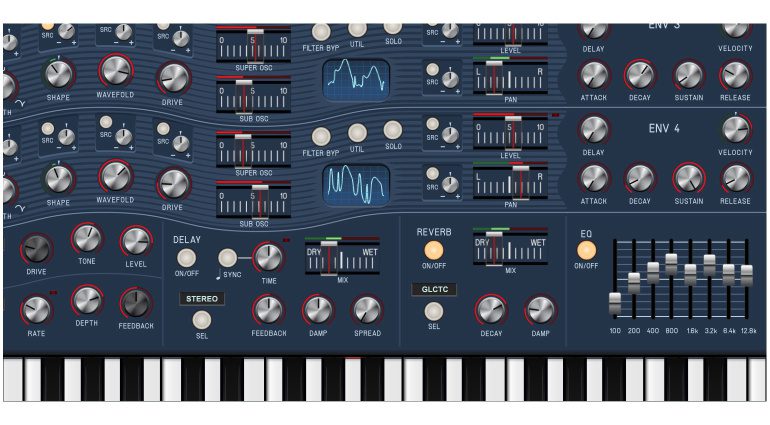
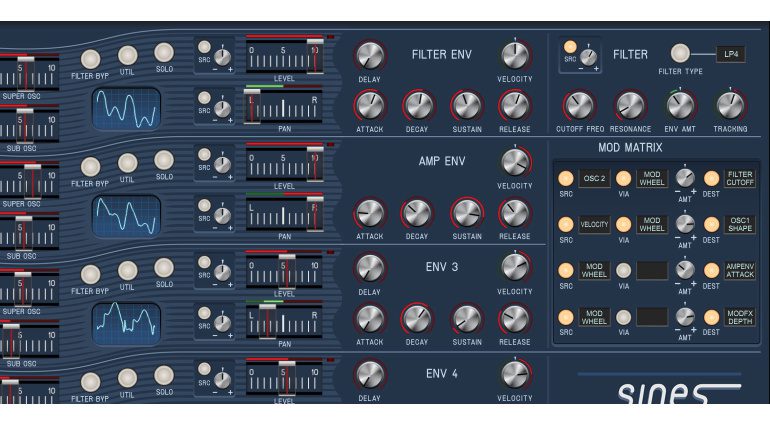
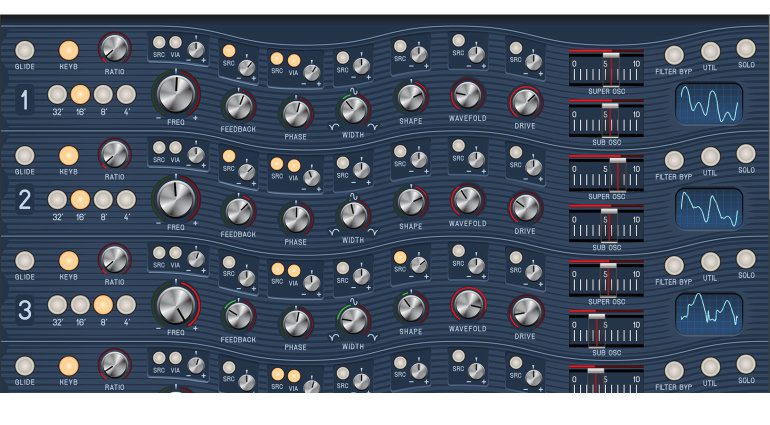





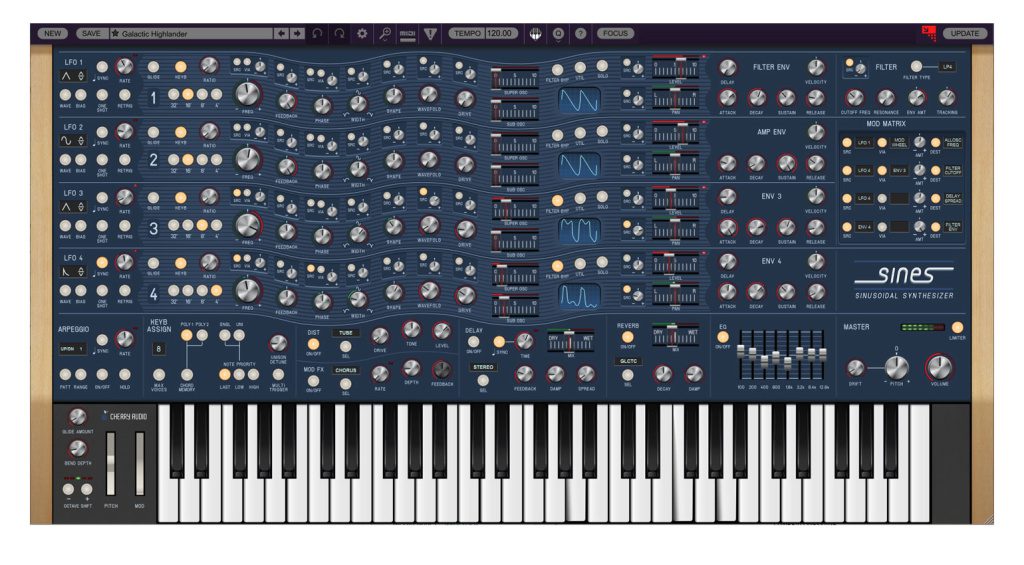
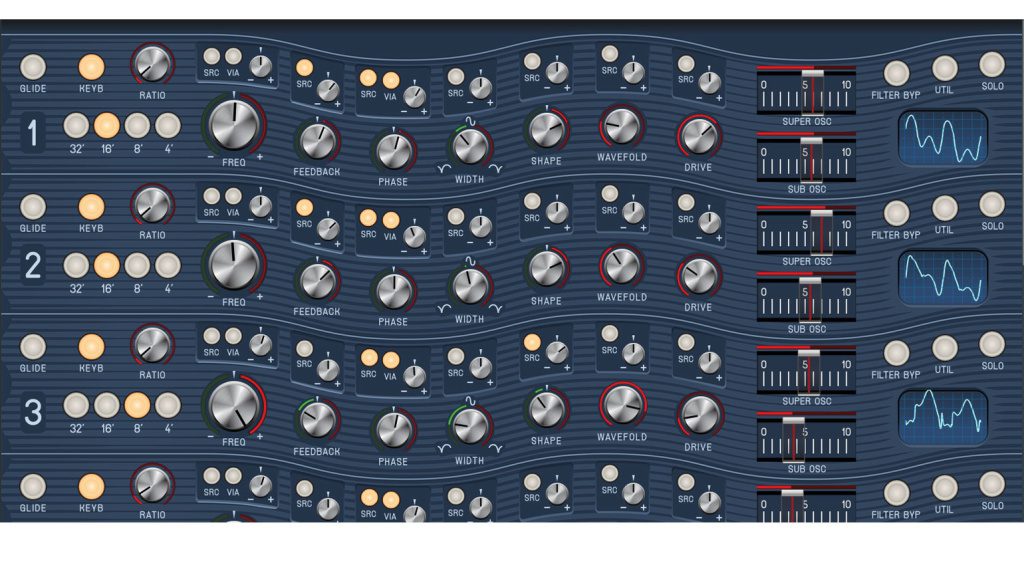
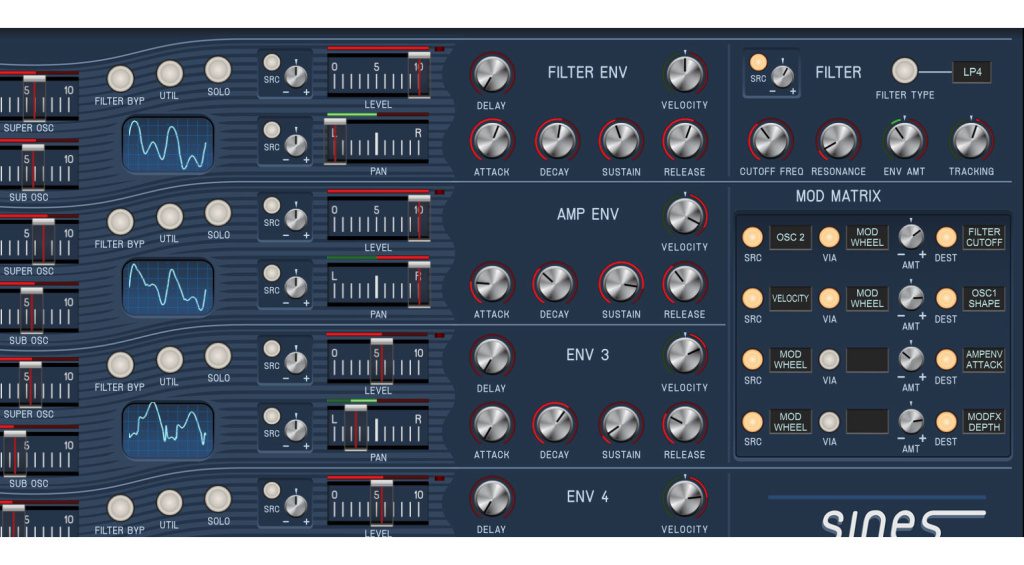
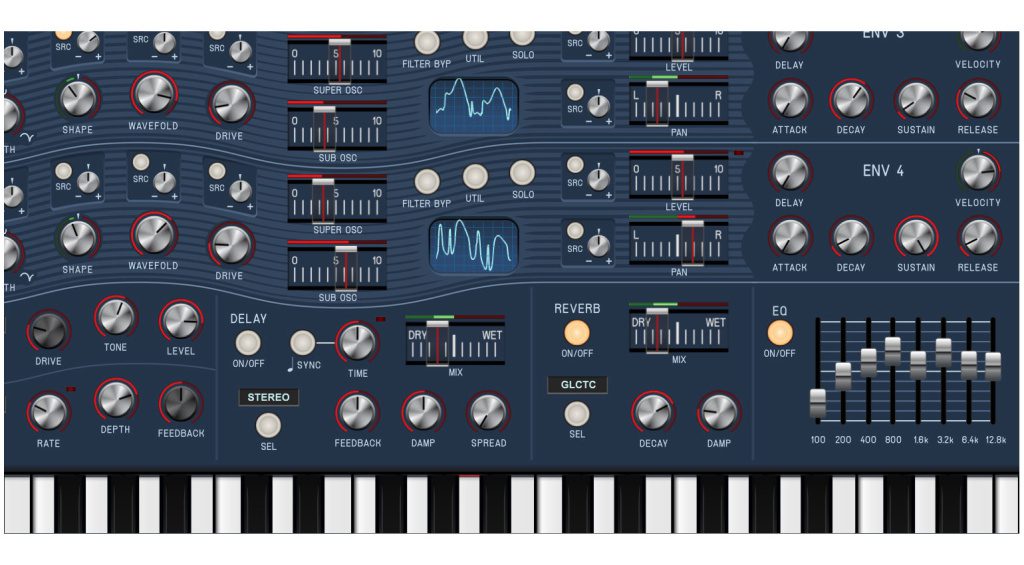

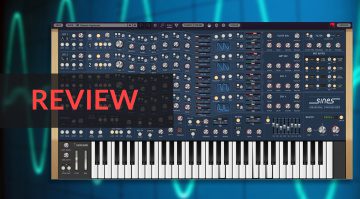


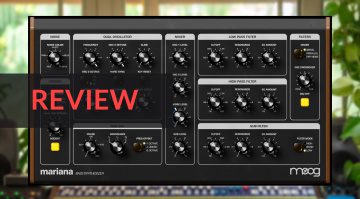
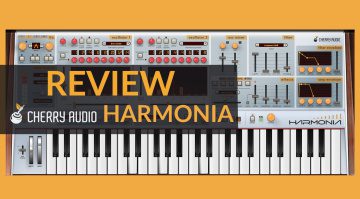

Cherry Audio is the best software company in the world.
great as usual